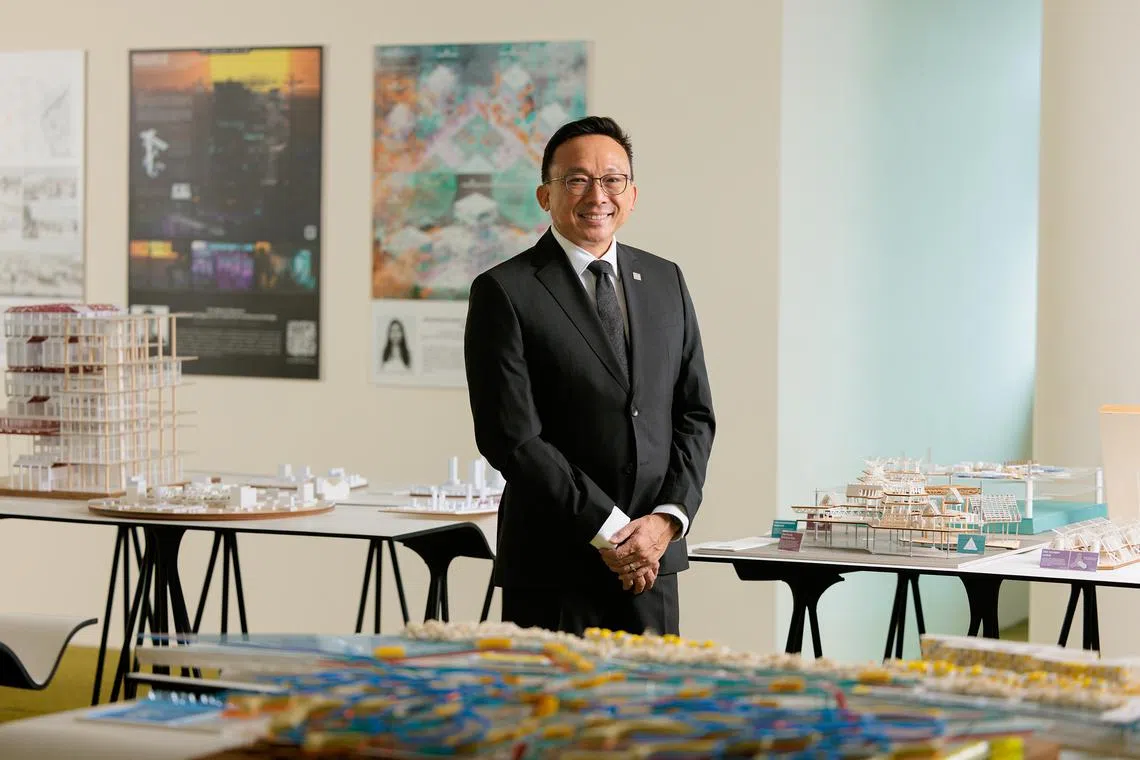Award-winning architect who led Pinnacle@Duxton project to join SUTD as full-time professor
Sign up now: Get ST's newsletters delivered to your inbox

Award-winning architect Khoo Peng Beng will start a new role as a professor of practice at the Singapore University of Technology and Design on Jan 1.
PHOTO: SUTD
Follow topic:
SINGAPORE – At the heart of Singapore stand seven 50-storey blocks. At 163m – just 2m shy of the Singapore Flyer – the Pinnacle@Duxton is the island’s tallest public residential complex.
Designed to line up in curves, the blocks are unobstructed by one another and linked by sky bridges, “for every unit to get fresh air and sunlight”, said architect Khoo Peng Beng, founder of ARC Studio Architecture + Urbanism, which designed the award-winning development.
Mr Khoo will soon bring his expertise to the Singapore University of Technology and Design (SUTD).
From Jan 1, he will be a professor of practice and head of the architecture and sustainable design pillar at the university.
“Many famous architects helm the deanship of schools in the US, but in Singapore I think this might be the first, where research that’s done in practice is being cross-pollinated into academia,” he told The Straits Times during a Zoom videoconferencing call on Dec 9.
He will still contribute to his practice at ARC Studio, but adopt a more supervisory role and take a back seat during project execution.
The 56-year-old has spent 31 years in practice and has taken on multiple projects abroad, but his favourite remains the Pinnacle@Duxton, which clinched the President’s Design Award in 2010.
As much as the glazing and cladding of the buildings are pristine, he finds a deeper meaning in their design – the emotions they evoke.
Unlike conventional Housing Board projects, there is no uniformity across the 1,848 units housed within 2.5ha of land. They have different facades – some have bay windows, some have balconies and others planters or extended living rooms.
Mr Khoo said: “Giving home owners more choices is important because it creates a sense of ownership, so that they can say, ‘I live there, I’m proud to live here’.
“That sense of belonging isn’t something material... yet can be made with material.
“You can get very nice facades and glass buildings, and a design can project a very powerful image, but liveliness may not come in tandem. We started looking at happiness, love and all these intangibles that a place can provide.”
The academia journey for Mr Khoo began in 2000 when he took on a part-time tutoring role at NUS.
He will leave NUS as an adjunct associate professor on Dec 31 before joining SUTD in the new year.
He spoke of his influences: the illustrious Ieoh Ming Pei, or I.M. Pei, known for designing the spectacular glass pyramid at the Louvre’s entrance and who taught at the Harvard Graduate School of Design; and former dean of the Yale School of Architecture Robert Stern, whose works include many residential skyscrapers in Manhattan, New York.
Mr Khoo said: “I can connect students with industry professionals in their area of inquiry, and expand conversations and get students to see from different perspectives.”
SUTD’s deputy president Tai Lee Siang described Mr Khoo as “the perfect blend of industry and academia” with extensive experience and network.
“Getting Peng Beng on board the SUTD team is a major coup,” he said.
But more importantly, beyond the technicalities of floor plans, Mr Khoo aims to teach his students to create environments that trigger positive human experiences.
He said: “In Singapore, we tend to start building from an efficiency point of view – looking at numbers and the economy of things – which is fantastic for economic and financial stability.
“But what about the higher needs of a human being? The need for freedom of choice, for fun and play. Could we also provide that in our design?”
As a lesson activity, students in his class may be asked to analyse how they feel as they walk through the city.
Mr Khoo said: “They might go to a part of Chinatown and think, ‘I’m quite fearful of this corner’. Or have a response like, ‘I want to know more about this place’. Or feel like they don’t belong.
“By understanding how designs affect them emotionally, they can create environments that are either very stressful and scary or an environment that fosters creativity, love and community.”
Budding architects will also have to navigate looming challenges, such as an increasing global population, environmental issues and the growing presence of artificial intelligence, said Mr Khoo.
SUTD, which has an interdisciplinary research programme that looks at major issues like sustainability and social well-being, gives students a platform to do so, he added.
“A place like SUTD is amazing because we build a small community of very innovative thinkers – do experiments, think of possible futures, challenge our current way of thinking and the norms – with the goal to make a better world.”
And although this goal might sound “heroic and lofty”, it is not beyond the reach of an architect, who is not simply someone who builds things, said Mr Khoo.
The veteran is metaphorical, almost esoteric, in his description of the job, saying: “We are masters in the manipulation of space and time, who look at the past to build the future; or alchemists, masterfully transforming earth and clay into something that serves humanity.
“We are also observers of people and culture, and help to transform dreams into realities.”
And with his ethos, Mr Khoo hopes to build the next makers of the future.


